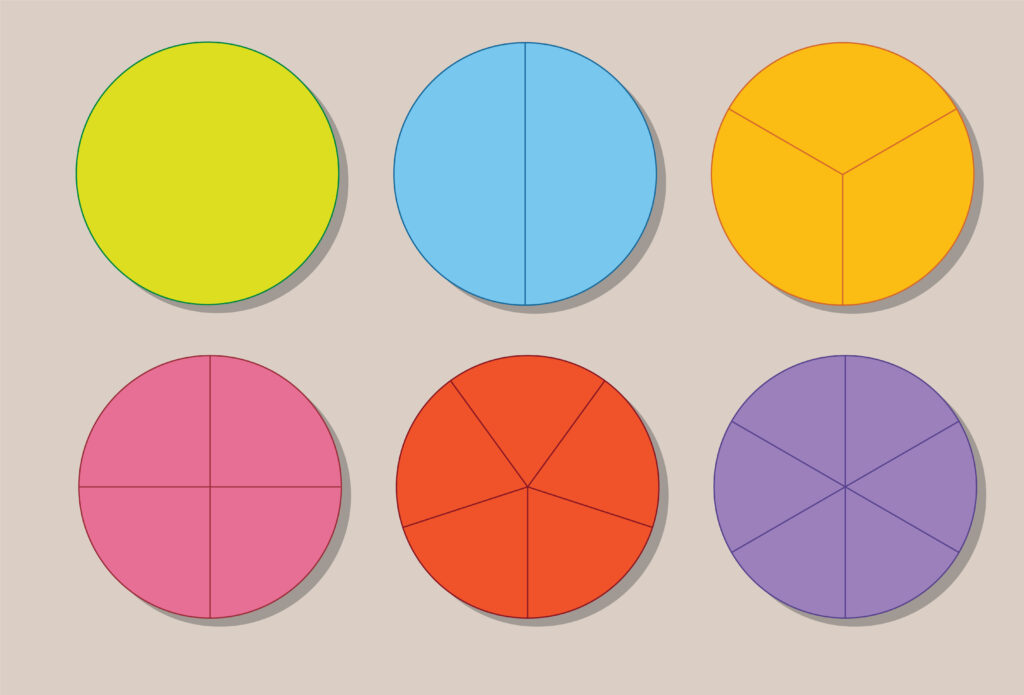At Educate Excellence, we believe that understanding maths starts with building confidence, especially when it comes to topics that many students find challenging. For many primary school children, fractions, decimals, and percentages can seem like separate and confusing concepts. But once students understand how they work and how they connect, these ideas become not only manageable, but meaningful.
This blog is designed to support both students and parents. Whether your child is just being introduced to fractions in Year 3 or preparing for SATs in Year 6, we’ll break these concepts down in a clear, practical way that encourages progress and removes anxiety.
What is a Fraction?
A fraction represents a part of a whole. Imagine slicing a pizza into equal parts, if you take some slices, you’ve taken a fraction of the pizza. A fraction is made up of two numbers: the top number is called the numerator, and it shows how many parts you have. The bottom number is the denominator, which shows how many equal parts the whole has been split into.
For example:
- ½ means 1 out of 2 equal parts = one half.
- ¾ means 3 out of 4 parts = three quarters.
Fractions are everywhere in everyday life. From dividing up a cake at a party, to sharing toys or treats fairly, to measuring ingredients when baking; children are already using fractions without even realising it. At Educate Excellence, we use these real-world examples to help children see fractions as useful and relevant, rather than just something written on a worksheet.
What is a Decimal?
A decimal is another way of showing a part of a whole, but instead of writing the number as a fraction, we use a decimal point. Decimals are based on the idea of dividing something into tenths, hundredths, and so on. This system helps children become familiar with place value beyond whole numbers.
For example:
-
- 0.5 is the same as ½ = five tenths.
- 0.25 is the same as ¼ = twenty-five hundredths.
- 0.75 is the same as ¾ = seventy-five hundredths.
Decimals are especially common in everyday settings. We use them when we talk about money (e.g. £1.50), lengths and measurements (e.g. 1.3 metres), or when reading scores or data (e.g. 8.5 out of 10). Helping your child get comfortable with decimals at an early age builds a strong foundation for later maths topics, especially in upper primary and secondary school.
What is a Percentage?
A percentage is a way of expressing a number as a part of 100. The symbol % literally means “out of 100”. So when we say 50%, we mean 50 out of 100, or half. It’s a simple way of comparing values on the same scale.
For example:
-
- 50% is the same as ½ or 0.5
- 25% is the same as ¼ or 0.25
- 75% is the same as ¾ or 0.75
Percentages are part of everyday conversations and experiences. We see them in sales (e.g. “25% off!”), school reports (e.g. “You scored 85%!”), and even in sports statistics. Teaching your child what percentages really mean and how they connect to fractions and decimals, makes maths feel more consistent and less overwhelming.
How Are They Connected?
Fractions, decimals, and percentages may look different, but they’re all different ways of showing the same idea, a part of something. That’s why understanding the connection between them helps make all three easier.
Let’s look at this simple comparison:
| Fraction | Decimal | Percentage |
| ½ | 0.5 | 50% |
| ¼ | 0.25 | 25% |
| ¾ | 0.75 | 75% |
Once students see that 0.5, ½, and 50% all mean the same thing, it reduces confusion and strengthens their number sense. At Educate Excellence, our tutors make these links visible and interactive, helping children feel more confident working with all three forms.
Tips for Helping Primary Students Understand
1. Use Visual Aids and Hands-On Learning
Children learn best when they can see and touch what they’re learning. Use objects like blocks, slices of fruit, coins, or even paper circles to demonstrate how parts make up a whole. Drawing number lines, bar models, and pie charts can also help them grasp the relationship between fractions, decimals, and percentages.
2. Bring Maths into Everyday Conversations
Real-life examples help children realise maths is all around them. For instance:
-
- “We’ve eaten half the pizza, that’s ½!”
- “You saved 25% of your allowance!”
- “You ran 0.75 of a kilometre, almost the whole way!”
3. Support at the Right Level
In Years 3 and 4, children learn simple fractions and begin working with tenths. In Years 5 and 6, they expand to hundredths, decimals, and percentages. Don’t worry if your child finds some parts hard, it’s completely normal. What matters most is building confidence and fluency over time.
At Educate Excellence, we personalise support to match your child’s level and learning style. Through practice, patience, and encouragement, we help every child make progress they can feel proud of.
How Educate Excellence Supports Your Child
Understanding fractions, decimals, and percentages is a key part of mastering primary maths. At Educate Excellence, we break down these complex topics into small, achievable steps. Our approach includes:
-
- Small group learning for personal attention and boosted confidence
- Visual tools and interactive activities that make abstract ideas concrete
- Tailored feedback and encouragement so every child feels successful
- SATs preparation that focuses on both accuracy and understanding
Our tutors are trained to recognise when a student is struggling and respond with practical strategies and warm encouragement. We make sure that no child feels left behind.
Turning Confusion Into Confidence
Fractions, decimals, and percentages are more than just school topics they’re tools children use to make sense of the world. When students learn how these concepts connect and how they relate to real life, they gain a deeper sense of understanding and confidence.
If your child is finding these topics difficult, or if you want to help them stretch further, Educate Excellence is here to help. Our experienced tutors support every learner not just academically, but emotionally too making maths feel achievable and even enjoyable.


